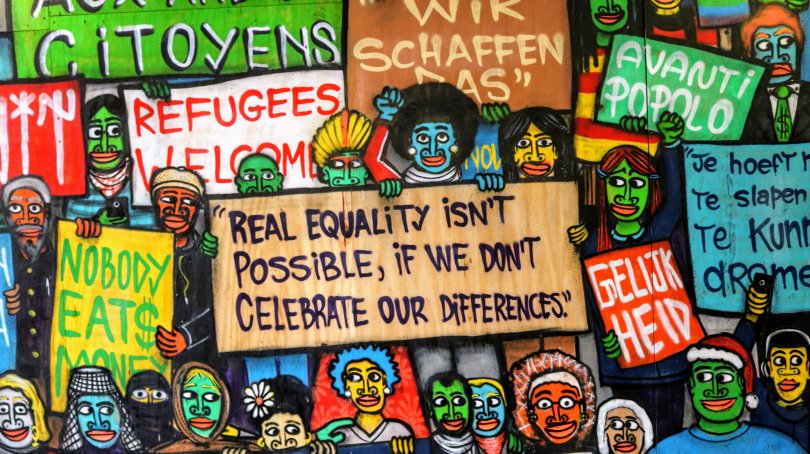How to Reduce Income Inequalities Among different individuals?

Photo par Jonathan Stutz sur Adobe Stock
Between age, social status, health, and education, we are not all equal when it comes to our income! However, even as equality becomes a major focus of study, most research concentrates on income disparities within homogeneous populations. In 2021, the economists Mathieu Faure and Nicolas Gravel developed a new way to measure inequality by looking at the differences between individuals. This small revolution can play a large role in the fight against the many faces of inequality.
In the World Inequality Report 20221, the economists Lucas Chancel, Thomas Piketty, Emmanuel Saez, and Gabriel Zucman raised the alarm on growing inequality. While it is decreasing between countries, inequality is growing within states, so that it is “close to early 20th century levels, at the peak of Western imperialism.” Yet progressive taxes implemented by the Welfare State later in the 20th century helped protect equal opportunity in education and healthcare. The economists do not mince words: “A similar evolution will be necessary in order to address the challenges of the 21st century.” According to them, we must therefore turn away from the 1980s deregulation and liberalization programs that have demonstrated “inequality is not inevitable; it is a political choice.”
The world Inequality report also notes that income inequality is not the only source of concern. Wealth inequality is also growing at a significant rate. According to the 2022 report, 10% of the wealthiest people in the world possess 76% of global assets. 50% of the poorest people only possess 2%. This trend was particularly noteworthy during 1995 to 2001, when the top 1% obtained 38% of all asset growth.
- 1Seuil, E. (s. d.). Rapport sur les inégalités mondiales ...
Numerous policies have been implemented for attenuating these raising inequalities, including international taxation, progressive taxes, corporate taxes, and even social programs such as unemployment and welfare benefits. A major challenge for economists and social scientists is to evaluate which of these policies have been the most efficient.
The case of France illustrates the difficulty. According to Chancel, Piketty, Saez and Zucman, inequality in this country of 67 million people was reduced in 2021. But what does this really mean? With such a large population, the gap between certain income levels can decrease while simultaneously growing among others. One of the most widely accepted definitions of a decrease in inequality is derived from the Pigou-Dalton transfer principle. This principle states that the transfer of a certain amount of income from a relatively rich individual to a relatively poorer person reduces inequality, as long as the relative ranking of the two individuals in terms of income is preserved following this transfer. Transfers of this kind logically lead to an income distribution that is more equal than it was before. Of course the Pigou-Dalton transfer principle can be applied to wealth – rather than income – distributions.

Photo by Matteo Paganelli on Unplash
When it comes to concretely reducing inequality however, the Pigou-Dalton transfer principle is not easy to implement. Economists have accordingly developed more operational criteria to determine if, in practice, one income – or wealth - distribution is more equal than another. These criteria, which are commonly used to assess tax policies or compare income distribution between countries, are all equivalent to each other as well as to the Pigou-Dalton transfer principle. The equivalence between these criteria and the Pigou-Dalton principle is an important theorem in mathematics, known as the Hardy-Littlewood-Polya theorem.
Tous égaux, face aux inégalités ?
La plupart des mesures d’inégalités concernent le revenu et ne tiennent pas compte des différences entre les individus ou groupes étudiés sur d’autres plans. Tout se passe comme si, mis à part les revenus, nous étions tous égaux. Pourtant, les différences de santé, d’éducation ou bien encore le nombre d’enfants à charge peuvent creuser les inégalités de revenus déjà existantes. La réduction des inégalités ne se fait que très rarement au sein d’une population homogène. Elle se pense au plein cœur d’une mosaïque variée faite de mille pièces biscornues et asymétriques.
En économie, quatre principaux outils sont utilisés classiquement pour identifier les situations les plus égalitaires après redistribution. Le premier considère les transferts (dits de Pigou Dalton) entre les individus les plus riches vers les plus pauvres. Le seconde est une approche philosophique qui considère que notre bonheur s’accroît avec l’augmentation du revenu, mais ce, de moins en moins à mesure que l’on s’enrichit. Si on offre 100 euros à une personne au revenu minimum, elle sera plus satisfaite que si on avait offert cette somme à un millionnaire. Selon cette approche, il y a réduction des inégalités si la somme du bien-être des individus est plus grande après redistribution qu’avant, quelle que soit la relation supposée entre bien-être et revenu satisfaisant cette propriété. Le troisième outil est la dominance des « courbes de Lorenz » d’après laquelle l’égalité augmente si la somme des revenus des k plus pauvres est plus élevée après la redistribution qu’avant quel que soit le nombre de pauvres considérés. Cette dominance, qui se base sur la courbe de Lorenz dont l’aire sert au calcul du fameux coefficient de Gini, établi par le statisticien et sociologue Corrado Gini en 1912, est largement utilisé pour évaluer l’inégalité de manière routinière par des milliers de statisticiens à travers le monde. Le quatrième est basé sur la réduction de la pauvreté, définie par la somme d’argent nécessaire pour amener tous ceux et celles dont le revenu est en bas d’un seuil de pauvreté au niveau de ce seuil. Cette approche énonce que la pauvreté est incontestablement réduite lorsque, quel que soit le seuil de pauvreté, la somme d’argent nécessaire pour l’élimination de cette pauvreté est plus faible.
Analyzing Inequalities among Unequals: First Approach
How do we define inequality reduction among different individuals? The researcher Nicolas Gravel has spent over twenty years trying to sort out this puzzle. He and the researcher Mathieu Faure published an article in 2021 which provides a very general definition of inequality reduction between non-similar agents, as well as operational tools to empirically check for this reduction. The approach developed by the two researchers applies to situations where the income recipients differ by another characteristic than their income, and where this other characteristic enables a ranking of the agents. This characteristic could be age, health status, education, household size, or something else entirely. The only requirement is that it must lead to a complete ranking of the agents. Hence, the approach does not apply to characteristics such as religion or gender that do not lead to a well-accepted ranking of agents. The researcher proposes to use this ranking of agents in terms of the non-income characteristic to qualify somehow the appraisal of the inequality in the income that these agents get. For example, if Pierre’s neighbor earns €500 more than him but is sick with an incurable disease, this illness and its impacts on his budget may lead us to conclude that he is not in fact “richer” than Pierre. We may therefore not endorse the statement – underlying the Pigou-Dalton transfer principle - that inequality between Pierre and his neighbor would be reduced if the latter was giving €100 to the former. For transfers to reduce inequality, the giver must not only be richer in income but also in a better position according to the other non-income ranking considered. The authors show that we can readapt the four classical economic notions of inequality reduction by adding this qualification to the transfer principle.
Their article responds to an economic debate that has been around for thirty years. They are the first to come up with a definition of equality in cases where individuals are distinguished by a characteristic other than income.
By considering how socio-economic differences influence inequality, their article opens up a completely new angle of exploration. The researchers invite others to follow their research at the empirical level, which could lead to the creation of targeted public policies. This could be a particularly effective tool, especially in development economics, if we look at the various aspects of poverty beyond income such as cultural capital, family conditions, access to healthcare, and more.
Between Economic Inevitability and Political Choice
As we seek to determine the best way to distribute income, wealth or “purchasing power”, economic innovation becomes part of a larger ethical and philosophical debate. Could we categorize “misfortune” by considering sexist or racist discrimination when studying inequality? Or are we only reduced to categorizing health, age, and household size? What do we base it on? The answers provided by economics to these questions must be based on clear and explicit normative premises. For example, many inequality analyses are based on the principle that individuals’ well-being is the ultimate source of ethical concern. Yet there are many different views on how individual well-being is defined and depends upon income and other variables, and how the well-being of different persons should be aggregated. Building tools for measuring income inequality by seeking consensus among a large class of these views therefore enrich the philosophical debate.

Photo by Tingey Injury Law Firm on Unplash
Between Economic Inevitability and Political Choice
As we seek to determine the best way to distribute income, wealth or “purchasing power”, economic innovation becomes part of a larger ethical and philosophical debate. Could we categorize “misfortune” by considering sexist or racist discrimination when studying inequality? Or are we only reduced to categorizing health, age, and household size? What do we base it on? The answers provided by economics to these questions must be based on clear and explicit normative premises. For example, many inequality analyses are based on the principle that individuals’ well-being is the ultimate source of ethical concern. Yet there are many different views on how individual well-being is defined and depends upon income and other variables, and how the well-being of different persons should be aggregated. Building tools for measuring income inequality by seeking consensus among a large class of these views therefore enrich the philosophical debate.
The economic methods used to evaluate redistribution policies (whether or not they take non-income differences differences into account) are held up against many political considerations. Consider for example the decision taken in August 2022 to improve the purchasing power of many French citizens through a 4% increase of pensions and other welfare benefits. Such a policy has clear redistributive consequences, in increasing the real consumption of several persons (the retired and the beneficiaries of the welfare payments for the most part), and by decreasing the purchasing power of the tax payers (present or future) who will bear the cost of this policy. It may also have an effect – very difficult to predict but presumably not favorable – on the overall growth of the economy. The tools developed by the authors could be mobilized to appraise in details the distributive consequences of such policy, possibly by also including among its possible effects the environmental impact of aggregate real income which, according to Eloi Laurent2, are often absent from the current discussion on “purchasing power”.
- 2Et si soutenir le pouvoir d’achat était… une mauvaise idée ? 2022, août 9. L’Obs.













